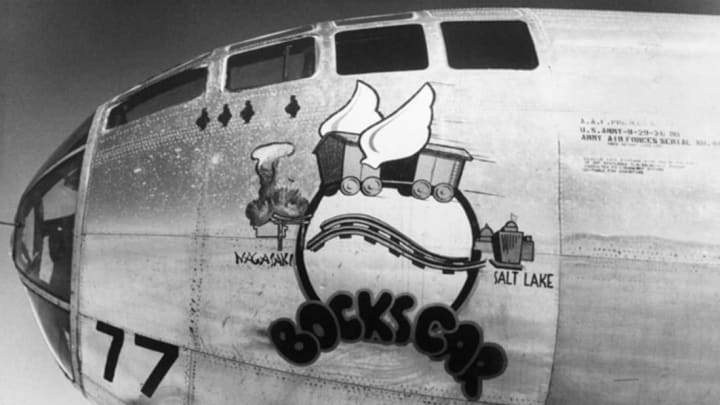Three days after the Enola Gay dropped warfare’s first atomic bomb on Hiroshima, the B-29 bomber once again droned high over Japan. Serving this time as a weather scout on Special Bombing Mission No. 16, the American aircraft spotted mostly clear skies above the city targeted for the second successive nuclear punch that the United States hoped would end World War II without a bloody invasion. Trailing hundreds of miles behind the Enola Gay, the Bockscar approached Japan carrying the most devastating weapon the world had ever known, and when the coded message crackled through the static that the primary target was visible and recommended for bombing, 25-year-old flight commander Major Charles Sweeney announced to his crew, “Kokura it is, men!”
Kokura—and not Nagasaki—was the original destination of the B-29 bomber convoy that flew over Japan 70 years ago on the morning of August 9, 1945. The city of 130,000 on the southern island of Kyushu was home to one of Japan’s biggest weapons arsenals, which according to American intelligence produced automatic weapons, combat vehicles, ordnance, and possibly poison gas. Kokura, now part of present-day Kitakyushu, had been one of the few Japanese cities lucky enough to escape American air raids, which was actually by design of the military—the blank canvas would demonstrate the weapon’s full destructive power.

Getty Images
As Bockscar approached Kokura around 9:45 a.m., the crew strapped on their parachutes and donned protective purple goggles. The B-29 buzzed 30,000 feet over the city with its pneumatic bomb bay doors open—but as bombardier Kermit Beahan peered through the rubber eyepiece of his Norden bombsight, he saw only gray clouds and black smoke in his crosshairs.
Beahan had been under orders to drop the bomb only if he had visual identification of the target—as much to ensure an accurate strike as to get a photograph of the mushroom cloud left in its wake. In the time since the Enola Gay had surveyed the city, however, a shifting wind had cloaked the Kokura Arsenal in a protective shroud of heavy smoke that presumably came from the overnight firebombing raid carried out by more than 200 B-29s on the neighboring industrial city of Yawata.
“I can’t see it! I can’t see the target!” a frustrated Beahan yelled. “No drop,” Sweeney barked into the intercom. “Repeat, no drop.”
Twice more the bomber passed over Kokura, but clouds and smoke continued to obscure the huge munitions factory in the heart of the city. With fuel running dangerously low and tensions running extremely high as Sweeney dodged anti-aircraft fire, the pilot ordered the convoy to abandon Kokura and fly 100 miles southwest to the secondary target.
Just after 11 a.m. the Bockscar dropped the plutonium bomb codenamed “Fat Man” on Nagasaki, killing as many as 80,000 people.
"The winds of destiny seemed to favor certain Japanese cities that must remain nameless," wrote New York Times reporter William Laurence, who accompanied the mission as a passenger on one of the B-29s. "We circled about them again and again and found no opening in the thick umbrellas of clouds that covered them. Destiny chose Nagasaki as the ultimate target."

Getty Images
Last year, however, an 85-year-old former steel worker suggested that it wasn’t just destiny that spared Kokura. Satoru Miyashiro, who worked at the nearby Yawata Steel Works during World War II, told the Japanese newspaper Mainichi Shimbun that he and his fellow workers created a manmade smoke screen when they heard radio reports on the morning of August 9, 1945, that American aircraft were flying toward Kokura.
As an air-raid siren sounded, Miyashiro’s supervisor instructed him to fire the incinerator, containing oil drums filled with coal tar, which caused black smoke to pour into the skies for two hours before the Bockscar flew overhead. The newspaper reported that the dark smoke that obscured Beahan’s view may not have come from the previous night’s bombing of Yawata after all, since local eyewitnesses reported that an overnight rainstorm had doused the smoke from the attack.
Whatever the smoke’s true source, it wasn’t the first time that fate had spared Kokura an atomic nightmare: The city was the Enola Gay’s secondary target had Hiroshima been clouded over. “We have complicated feelings,” local historian Saburo Yonezu told the New York Times in 1985. “We are half grateful that we survived. But the other half is that we also feel sorry that Nagasaki suffered instead of us.”
Seventy years later, a peace bell presented by Nagasaki residents stands at the arsenal’s former location and tolls as a reminder of Kokura’s narrow escape [PDF].
